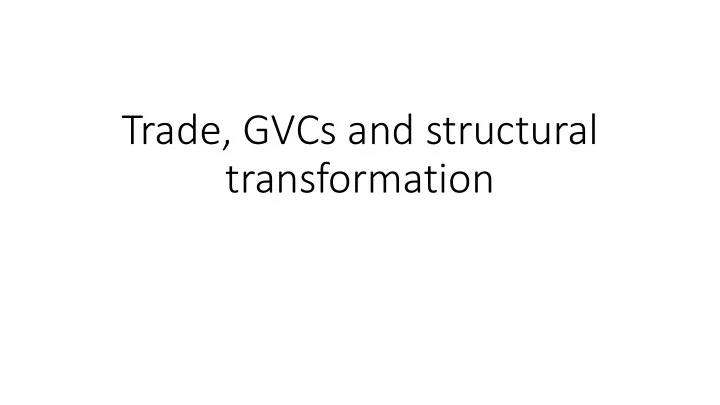

Trade, GVCs and structural transformation
Context • In recent years, trade has transformed (mostly as a result of technological change) in a number of ways: • Global value chains have emerged • Trade in services has grown faster than trade in goods • The participation of developing countries has increased • In several, mostly developed, countries, concerns regarding the effects of trade and trade agreements on workers have figured prominently in political debates • There is now a sizeable literature that examines the effect of trade on firms and workers
Main points • Trade allows specialization according to comparative advantage which involves the reallocation of workers and capital from less to more productive activities • Trade induces inter-sectoral reallocation of resources • Trade has other important effects on the structure of employment • GVCs are associated with structural transformation in developing countries • Digital technologies will lower trade costs, change the composition of trade and change comparative advantage • Policy interventions are needed to mitigate adjustment costs and to ensure that GVC benefits are shared
Trade and structural change in developed countries • Trade induces reallocation of resources both within and between firms, industries and sectors • Trade’s contribution to deindustrialization in developed countries seems to be modest • Evidence suggests that the steady decline in the share of manufacturing in total employment in developed countries since the 1950s is driven by (unskilled labour saving) technological progress and changes in preferences as income rises • Trade raises the demand for skilled workers and contributes to polarization • When geographical mobility is limited, trade also raises regional disparities • Adjustment can be long and costly
GVCs, structural change and employment • GVCs have strengthened inter- and intra-industry linkages over the last decades • While 7.3% of Belgian firms export, 42.4% supply exporters directly or indirectly and are thus dependent on foreign demand • Import competition hurts supplier (upstream) industries when their customers contract. On the contrary, import competition affecting their suppliers benefits customer industries • The rise of value chains is likely to also have exacerbated the effect of trade and offshoring on the demand for skills
Trade, GVCs and structural change in developing countries • In resource rich countries, mostly in Latin America and Africa, trade and globalization may have played a comparatively bigger role in contributing to “premature de - industrialization”. Premature deindustrialization can have serious consequences, both economic and political. • In Asia, by contrast, countries with a strong comparative advantage in manufactures have managed to avoid manufacturing employment losses, and where they have occurred, they have been less severe. • Trade also raises the demand for skilled workers in developing countries • Adjustment in developing countries may involve transition through informal employment • GVCs can provide an opportunity for countries to integrate into the global economy at lower costs by producing only certain components or tasks rather than complete products • Initial integration into GVCs typically leads to a productivity-enhancing movement of labour from agriculture to manufacturing and services. Participation in GVCs however also involves risks.
Trade in the digital age • Digital technologies reduce trade costs which boosts trade • Digital technologies affect trade patterns: • More trade in services • Increasing importance of data flows and intellectual property • More trade in time-sensitive, certification-intensive and contract-intensive goods • Mass customization • Trade in digitizable goods is likely to continue falling • Digital technologies affect comparative advantage • Overall, new technologies create challenges and opportunities, but on balance they seem to be enhancing trade and GVCs (WB 2019)
Adjustment policies • Governments of richer countries can use a mix of adjustment, competitiveness and compensation policies to help workers manage the cost of adjusting to technological change and trade, while making sure that the economy captures as much as possible the benefits from these changes • This need for a mix of approaches also broadly applies to poorer countries but one needs to take into account the larger share of workers in informality, limited supply-side capacities, and weaker institutions. • Beyond improving economic efficiency, adjustment policy offers a way to compensate those who lose out from the dislocation caused by economic change and it can also help maintain political support for innovation and trade openness. • General adjustment programmes can deal with a wider range of economic changes but trade-targeted programmes can be cheaper than those that cover all types of these shocks. • Adjustment policies take different forms • Active (e.g. retraining) and passive (e.g. unemployment insurance) labour market policies • Other policies that help reduce frictions and adjustment costs
National policies to boost GVC participation • Endowments • FDI: adopt supportive investment policy and improve the business climate • Improve access to finance • Labor costs: avoid exchange rate misalignment, educate, train and open to foreign skills • Market size • Improve access to inputs and access to foreign markets • Geography • Improve trade infrastructure and ICT connectivity • Institutions • Improve governance (predictability and stability) and rule of law Source: World Development Report 2020
Recommend
More recommend